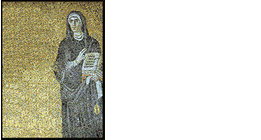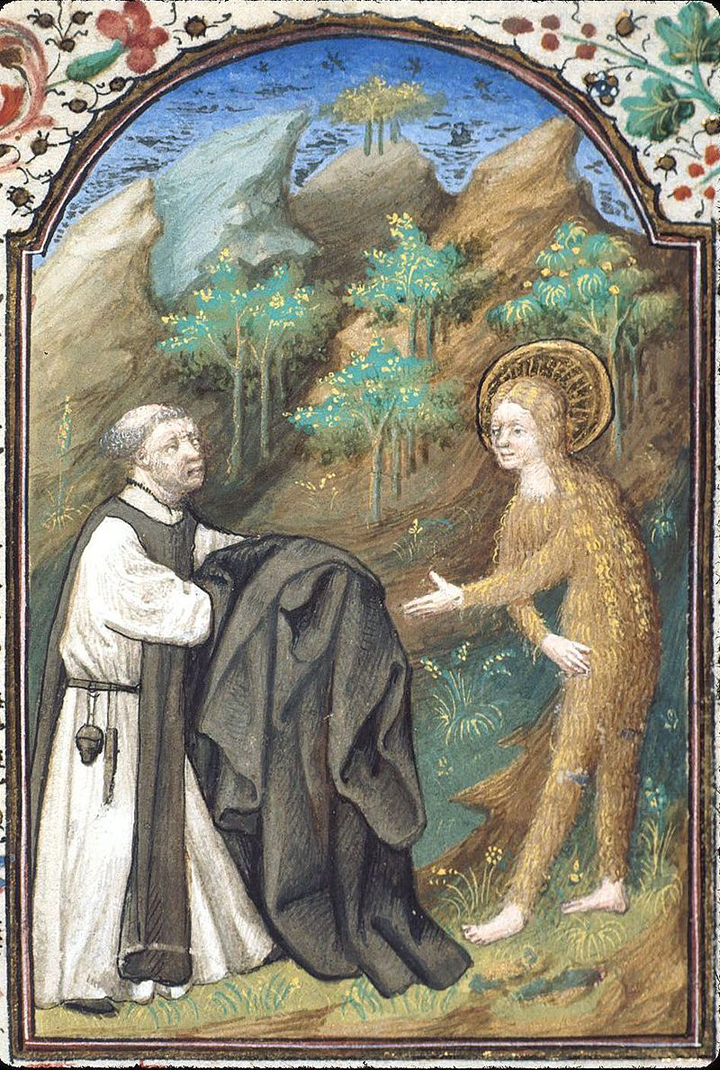 |
|
|
|
|
Class Prep
|
|
|
|
Ascetic
Fasting: Anorexia as a Path to Power
 Today's reading moves from Greek and Roman medical notions
of the body and diet to the applications of these ideas
in the works of well-educated Christian authors. We will
read what Basil of Ancyra, Gregory of Nyssa and Jerome said
about the physiology and purpose of ascetic fasting (one of the physiological consequences of severe fasting for women that these men don't talk about is the suppression of estrogen production, leading to the growth of body hair, as in the15th-century French manuscript illumination of Zosimus and Mary of Egypt to the right). Jerome
will be particularly defensive on the issue of his encouragement of women's fasting, because his
promotion of one young woman's ascetic regimen led to
her untimely death four months after her conversion to Christianity
and an ascetic diet. But he is defensive for other reasons
as well, chiefly that his ascetic program seemed to many
fellow Christians like an almost gnostic repudiation of
the material world. As you read today's section from Shaw's
book, be able to identify the chief features of the three
Christian authors' views, and how they grounded these in
scripture. Today's reading moves from Greek and Roman medical notions
of the body and diet to the applications of these ideas
in the works of well-educated Christian authors. We will
read what Basil of Ancyra, Gregory of Nyssa and Jerome said
about the physiology and purpose of ascetic fasting (one of the physiological consequences of severe fasting for women that these men don't talk about is the suppression of estrogen production, leading to the growth of body hair, as in the15th-century French manuscript illumination of Zosimus and Mary of Egypt to the right). Jerome
will be particularly defensive on the issue of his encouragement of women's fasting, because his
promotion of one young woman's ascetic regimen led to
her untimely death four months after her conversion to Christianity
and an ascetic diet. But he is defensive for other reasons
as well, chiefly that his ascetic program seemed to many
fellow Christians like an almost gnostic repudiation of
the material world. As you read today's section from Shaw's
book, be able to identify the chief features of the three
Christian authors' views, and how they grounded these in
scripture.-
- A contemporary theologian, Michelle Lelwica, wrote a book called Starving for Salvation,
in which she explores the spiritual roots of contemporary
anorexia. She wonders if there are similarities between
the way women in particular were encouraged to renounce
their bodies in Christian antiquity, and the way women today
choose to control their bodies by depriving themselves of
nutrition. We began reading a chapter by her last week, and finish it today. Do you agree with her that anorexia today has
a spiritual dimension? Do you think it is in any way similar
to the promotion of asceticism in early Christianity?
-
-
- Assigned Readings
-
- Secondary: Burden of the Flesh 79-112; read pp. 27-38 from Lelwica, Starving for Salvation (Camino); online class prep
-
- Slides for Lecture
-
-
- Further Reading
-
- Bell, Rudolph M. Holy Anorexia. Chicago: University of Chicago Press, 1985.
-
- Bynum, Caroline Walker. Holy Feast and Holy Fast: The Religious Significance of Food to Medieval Women. Berkeley: University of California Press, 1987.
-
- Cain, Andrew Jason. The Letters of Jerome: Asceticism, Biblical Exegesis, and the Construction of Christian Authority in Late Antiquity. New York: Oxford University Press, 2009.
-
- Clark, Elizabeth A. "Reading Asceticism: Exegetical Strategies in the Early Christian Rhetoric of Renunciation." Biblical Interpretation 5:1 (1997) 82-105.
-
- Kelly, J. N. D. Jerome: His Life, Writings, and Controversies. New York: Harper & Row, 1975.
-
- Lacey, J. M. "Anorexia Nervosa and a Bearded Female Saint." British Medical Journal 285 (1982) 1816-18l7.
-
- Ranke-Heinemann, Uta. Eunuchs for the Kingdom of Heaven: Women, Sexuality, and hte Catholic Church. New York: Doubleday, 1990.
-
- Vandereycken, Walter and Ron van Deth. From Fasting Saints to Anorexic Girls: The History of Self-starvation. Washington Square, New York: New York University Press, 1994.
-
-
-
- Sources
-
- Photograph: "Icon of Mary of Egypt, covered in golden hair, being handed a cloak by Zosimas," Yates Thompson 3 f.287, Paris, France, 15th century (British Library), Wikipedia, online, https://en.wikipedia.org/wiki/Mary_of_Egypt#/media/
File:Mary_of_Egypt_british_library.jpg.
|
|
|
|
|
|
|
